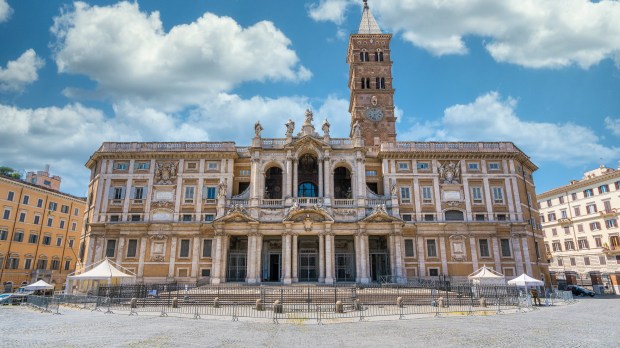Lenten Campaign 2025
This content is free of charge, as are all our articles.
Support us with a donation that is tax-deductible and enable us to continue to reach millions of readers.
The day after his election, on March 14, 2013, Pope Francis surprised the general public by leaving the Vatican at dawn to pray before the icon Salus Populi Romani — Salvation of the Roman People — which is kept in a chapel in the Basilica of St. Mary Major.
This unexpected outing, tinged with discretion, was to be the first in a long list of visits to this image of Mary dear to the Romans. The city venerates Mary under this title — the icon of which is traditionally attributed to St. Luke — as a patron saint, invoked particularly in times of disaster.

Pope Francis has made it a custom to visit this papal basilica, located near Termini Station, before and after each of his trips — in petition and then in thanksgiving — and to entrust to the Virgin Mary the great events of the Church.
August 5, the feast of the Basilica’s founding, was no less than his 116th visit there. He took part in the Basilica’s annual festivities, witnessing the traditional shower of rose petals.
Each year, thousands of petals are thrown from the dome onto the crowd to commemorate the miracle of the basilica’s origin. According to the story, in the year 358, the Virgin Mary caused snow to fall in the middle of August on the summit of the Esquilino, to show Pope Liberius where she wished a church to be built in her honor.
The site of Jorge Mario Bergoglio’s last days?
On December 8, the feast of the Immaculate Conception, Francis honored the Salus Populi Romani with a golden rose.
So, when we learned a few days afterward that the Argentinian pontiff wishes to be buried in this basilica, in a break with his recent predecessors, who have their tombs in St. Peter’s, it was perhaps not entirely a surprise. His choice seemed yet another sign of his profound devotion.
Since then, Pope Francis has spoken several times of this tomb, which is now prepared.
In his recent book El Sucesor (“The Successor”), he recounts: “Just beyond the sculpture of the Queen of Peace, there’s a small recess, a door that leads to a room where candelabras were stored. I saw it and thought, ‘This is the place.’ And that’s where the burial site was prepared. I’ve been told it’s ready.”
In addition to the future tomb of the 266th pope, St. Mary Major could also become his place of retirement. In his biography Life: My Story through History, he said that he might choose to live the last years of his life there, if he should discern that God asks him to retire.
He specified that he would devote his time to a ministry of hearing Confessions and “taking Communion to the sick.” Some voices in Rome whisper that preparations have been carried out in recent months to ready for this eventuality. There is also talk of a brand new, secure apartment in the canons’ space. Speculation is rife, although the Holy See Press Office replies that the work is simply a matter of renovating the accommodations for the community of priests who live there.



